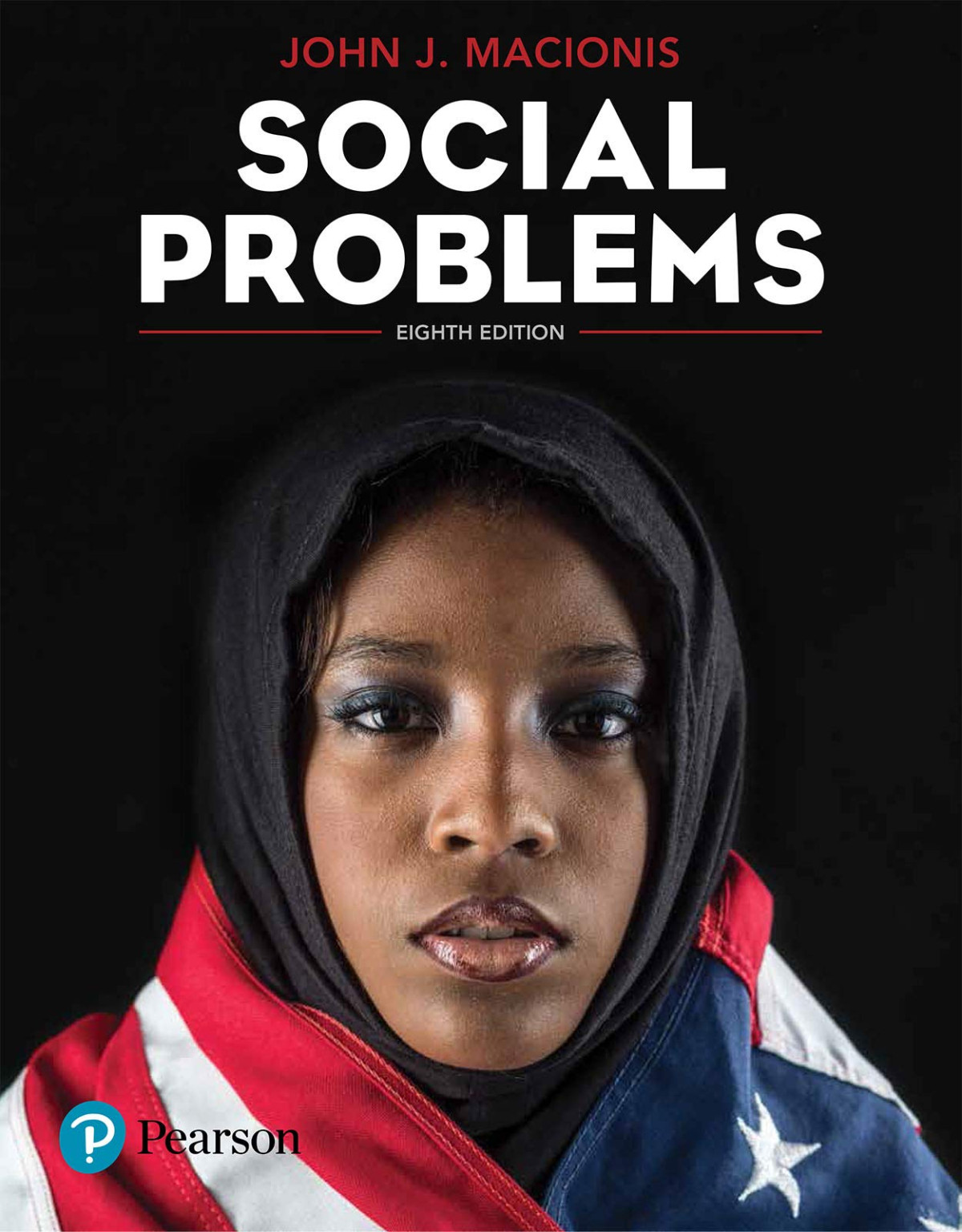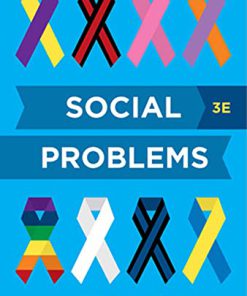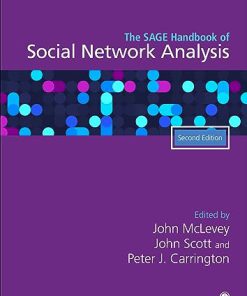Social Problems 8th Edition by John Macionis ISBN 9780135227930 0135227933
$50.00 Original price was: $50.00.$25.00Current price is: $25.00.
Social Problems 8th Edition by John Macionis – Ebook PDF Instant Download/Delivery: 9780135227930 ,0135227933
Full download Social Problems 8th Edition after payment

Product details:
ISBN 10: 0135227933
ISBN 13: 9780135227930
Author: John Macionis
Social Problems 8th Edition Table of contents:
Part I
Chapter 1 Sociology: Studying Social Problems
Learning Objectives
Seeing Patterns: The Sociological Imagination
Social Problems: The Basics
Social Problems over Time
The Social-Constructionist Approach
Claims Making
Problems and Social Movements
Stages in Social Movements
Social Problems: Eight Assertions
Social Problems: A Global Perspective
Analyzing Social Problems: Sociological Theory
The Structural-Functional Approach
Early Functional Theory: Problems as Social Pathology
The Chicago School: Problems as Disorganization
More Recent Functionalism: Problems as Dysfunctions
The Social-Conflict Approach
Marxist Theory: Problems and Class Conflict
Multiculturalism: Problems of Racial and Ethnic Inequality
The Feminist Approach
The Symbolic-Interaction Approach
Learning Theory: Problems and the Social Environment
Labeling Theory: Problems and Social Definitions
Finding the Facts: Sociological Research
Research Methods
Survey Research: Asking Questions
Field Research: Joining In
Experimental Research: Looking for Causes
Secondary Analysis: Using Available Data
Truth, Science, and Politics
Truth and Statistics
Responding to Social Problems: Social Policy
Policy Evaluation
Policy and Culture
Policy and Politics
Politics Constructing Problems and Defining Solutions
The Political Spectrum
Conservatives, Liberals, and Radicals
Social Issues
Leaning Left
Leaning Right
Economic Issues
Leaning Left
Leaning Right
Who Thinks What?
A Word about Gender
A Word about Political Parties and the 2016 Presidential Election
Going On from Here
Defining Solutions Chapter 1 Sociology: Studying Social Problems
Whose problem is it?
Getting Involved: Applications and Exercises
Making the Grade Chapter 1 Sociology: Studying Social Problems
Seeing Patterns: The Sociological Imagination
Social Problems: The Basics
Analyzing Social Problems: Sociological Theory
Macro-Level
Micro-Level
Finding the Facts: Sociological Research
Responding to Social Problems: Social Policy
Politics Constructing Problems and Defining Solutions
Part II
Chapter 2 Economic Inequality
Learning Objectives
Economic Inequality in the United States
Inequality of Income and Wealth
The Trend toward Increasing Economic Inequality
Taxation
The Rich and the Poor: A Social Profile
The Rich
The Poor
The Poverty Line
The Poverty Gap
Who Are the Poor? A Closer Look
Age
Race
Gender
Family Patterns
Region
Working Families: Working Harder
The Working Poor
The Nonworking Poor
The Underclass
Problems Linked to Poverty
Poor Health
Substandard Housing
Homelessness
Limited Schooling
Crime and Punishment
Political Alienation
Responding to Poverty: The Welfare System
A Brief History of Welfare
The Colonial Era
The Early Industrial Era
The Twentieth Century
The 1996 Welfare Reform
Theories of Poverty
Structural-Functional Analysis: Some Poverty Is Inevitable
Social Pathology Theories: Personal Deficiency
Social Disorganization Theory: Too Much Change
Modern Functional Theory: Some Inequality Is Useful
Symbolic-Interaction Analysis: Defining the Problem
Social-Conflict Analysis: Poverty Can Be Eliminated
Marxist Theory: Poverty and Capitalism
More Than Money: Cultural Capital
Multicultural Theory: Poverty, Race, and Ethnicity
Feminist Analysis: Poverty and Patriarchy
The Feminization of Poverty
Intersection Theory: Multiple Disadvantages
Politics and Economic Inequality Constructing Problems and Defining Solutions
Conservatives: Personal Responsibility
Liberals: Societal Responsibility
The Radical Left: Change the System
Join The Debate
Going On from Here
Defining Solutions Chapter 2 Economic Inequality
Is economic inequality a problem?
Getting Involved: Applications and Exercises
Making the Grade Chapter 2 Economic Inequality
Economic Inequality in the United States
The Rich and the Poor: A Social Profile
Problems Linked to Poverty
Responding to Poverty: The Welfare System
Theories of Poverty
Structural-Functional Analysis: Some Poverty Is Inevitable
Symbolic-Interaction Analysis: Defining the Problem
Social-Conflict Analysis: Poverty Can Be Eliminated
Feminist Analysis: Poverty and Patriarchy
Politics and Economic Inequality Constructing Problems and Defining Solutions
Conservatives: Personal Responsibility
Liberals: Societal Responsibility
The Radical Left: Change the System
Chapter 3 Racial and Ethnic Inequality
Learning Objectives
Race and Ethnicity
Race
When Was Race Invented?
Are Races Real?
Should Races Exist at All?
Multiracial People
Ethnicity
Minorities
Visibility
Power
Numbers
White Privilege
Immigration
The “Great Immigration”
Nativists and the Quota System
The End of the Quota System
The Current Immigration Controversy
Patterns of Majority–Minority Interaction
Genocide
Segregation
Assimilation
Pluralism
The Social Standing of U.S. Minorities
Native Americans
African Americans
Asian Americans
Hispanic Americans/Latinos
Arab Americans
Prejudice
Stereotypes
Racism
Measuring Prejudice: The Social Distance Scale
Institutional Racism: The Case of Racial Profiling
Causes of Prejudice
Personality Factors
Societal Factors
Multiculturalism
Discrimination
Institutional Discrimination
Prejudice and Discrimination: A Vicious Circle
Microaggression
Affirmative Action: Reverse Discrimination or Cure for Prejudice?
History of Affirmative Action
Theories of Racial and Ethnic Inequality
Structural-Functional Analysis: The Importance of Culture
The Culture of Poverty
Symbolic-Interaction Analysis: The Personal Meaning of Race
Social-Conflict Analysis: The Structure of Inequality
The Importance of Class
Multicultural Theory
Politics, Race, and Ethnicity Constructing Problems and Defining Solutions
The Far Right and Conservatives: Culture and Effort Matter
Liberals: Society and Government Matter
The Radical Left: Fundamental Changes Are Needed
Going On from Here
Defining Solutions Chapter 3 Racial and Ethnic Inequality
Is increased immigration to the United States a problem?
Getting Involved: Applications and Exercises
Making the Grade Chapter 3 Racial and Ethnic Inequality
Race and Ethnicity
Patterns of Majority–Minority Interaction
The Social Standing of U.S. Minorities
Prejudice
Discrimination
Theories of Racial and Ethnic Inequality
Structural-Functional Analysis: The Importance of Culture
Symbolic-Interaction Analysis: The Personal Meaning of Race
Social-Conflict Analysis: The Structure of Inequality
Politics, Race, and Ethnicity Constructing Problems and Defining Solutions
Far Right and Conservatives: Culture and Effort Matter
Liberals: Society and Government Matter
The Radical Left: Fundamental Changes Needed
Chapter 4 Gender Inequality
Learning Objectives
What Is Gender?
Patriarchy
Explanations of Patriarchy
Prejudice and Discrimination
The Problem of Sexism
Gender and Social Institutions
Gender and the Family
Gender and Education
Gender and College Sports
Gender and the Mass Media
Gender and Politics
Gender and Religion
Gender and the Military
Gender and Work
Gender Stratification
Income
Three Reasons for the Gender Gap in Pay
The Glass Ceiling
Housework
Violence against Women
Sexual Harassment
Sexuality, Beauty, and Reproduction
Women: A Majority Minority?
Theories of Gender Inequality
Structural-Functional Analysis: Gender and Complementarity
Talcott Parsons: A Theory of Complementary Roles
Symbolic-Interaction Analysis: Gender in Everyday Life
Gender and Personal Behavior
Gender and the Use of Space
Gender and Language
Social-Conflict Analysis: Gender and Inequality
Friedrich Engels: The Rise of Patriarchy
Intersection Theory: The Case of Minority Women
Feminism
Feminist Foundations
Types of Feminism
Liberal Feminism
Socialist Feminism
Radical Feminism
Multicultural and Global Feminism
Politics and Gender Constructing Problems and Defining Solutions
Conservatives: The Value of Families
Liberals: The Pursuit of Equality
The Radical Left: Change the System
Going On from Here
Defining Solutions Chapter 4 Gender Inequality
Is gender inequality in college athletics a problem? If so, what is the solution?
Getting Involved: Applications and Exercises
Making the Grade Chapter 4 Gender Inequality
What Is Gender?
Gender and Social Institutions
Family
Education
Mass Media
Politics
Religion
Military
Work
Gender Stratification
Theories of Gender Inequality
Structural-Functional Analysis: Gender and Complementarity
Symbolic-Interaction Analysis: Gender in Everyday Life
Social-Conflict Analysis: Gender and Inequality
Feminism
Politics and Gender Constructing Problems and Defining Solutions
Conservatives: The Value of Families
Liberals: The Pursuit of Equality
The Radical Left: Change the System
Chapter 5 Sexuality and Inequality
Learning Objectives
What Is Sex?
Sex: A Biological Issue
Sex: A Cultural Issue
Sexual Attitudes in the United States
The Sexual Revolution
The Sexual Revolution and Feminism
The Sexual Counterrevolution
The Continuing Sexual Revolution: Older People
Sexual Orientation
Homosexuality
The Extent of Homosexuality
What Determines Sexual Orientation?
Cultural Factors
Biological Factors
Homosexuality, Inequality, and Public Policy
Same-Sex Marriage
The Gay Rights Movement
The Transgender Movement
Sexuality, Inequality, and Controversy
Pornography
What Are the Effects of Viewing Pornography?
Pornography and Violence
Is Pornography a Social Problem?
Conservatives: The Moral Issue
Liberals: Issues of Freedom and Power
Sexual Harassment
Who Harasses Whom? A Court Case
Must Harassment Harm Victims? Other Court Cases
Prostitution
Prostitutes: A Profile
Arrests for Prostitution
Child Prostitution and Sex Trafficking
Teenage Pregnancy and Parenthood
The Costs of Teenage Pregnancy
Sex Education: A Solution?
Abortion
Abortion: A Look Back
The Abortion Controversy Today
Sexually Transmitted Infections
Gonorrhea and Syphilis
Genital Herpes
AIDS
Extent of the AIDS Problem in the United States
Extent of the AIDS Problem in the World
How HIV Progresses and is Transmitted
Combating AIDS
Theories of Sexuality
Structural-Functional Analysis: Controlling Sexuality
Incest and Legitimacy
The Functions of Prostitution
Symbolic-Interaction Analysis: Defining Sexuality
The Meaning of Virginity
Learning Sexual Roles: The Case of Topless Dancers
Defining Sexuality: The Transgender Movement
Social-Conflict Analysis: Feminist Theory and Queer Theory
Feminist Theory: Women as Sexual Objects
Queer Theory
Politics and Sexuality Constructing Problems and Defining Solutions
Conservatives and the Far Right: The Value of Traditional Morality
Liberals: Sex and Individual Choice
The Radical Left: Go to the Root of the Problem
Going On from Here
Defining Solutions Chapter 5 Sexuality and Inequality
Is it OK for young people to be sexually active?
Getting Involved: Applications and Exercises
Making the Grade Chapter 5 Sexuality and Inequality
What Is Sex?
Sexual Attitudes in the United States
Sexual Orientation
Sexuality, Inequality, and Controversy
Pornography
Sexual Harassment
Prostitution
Teenage Pregnancy
Abortion
Sexually Transmitted Infections
Theories of Sexuality
Structural-Functional Analysis: Controlling Sexuality
Symbolic-Interaction Analysis: Defining Sexuality
Social-Conflict Analysis: Feminist Theory and Queer Theory
Politics and Sexuality Constructing Problems and Defining Solutions
Conservatives and the Far Right: The Value of Traditional Morality
Liberals: Sex and Individual Choice
The Radical Left: Go to the Root of the Problem
Chapter 6 Aging and Inequality
Learning Objectives
Growing Old
Industrialization and Aging
Preindustrial Societies: Elders as Social Elite
Industrial Societies: Elderly as Social Problem
Life Expectancy
The Graying of the United States
Elders: A Diverse Population
Three Levels of “Old”
Class, Race, Ethnicity, and Gender
Problems of Aging
Social Isolation
Retirement
Ageism
Age-Based Prejudice
Age-Based Discrimination
Ageism in the Mass Media
Victimization of the Elderly
Causes of Elder Abuse
The Growing Need for Caregiving
Poverty
Age Stratification
Housing
Housing Programs for Older People
Medical Care
Death and Dying
Euthanasia and the Right to Die
Euthanasia in Europe
Euthanasia in the United States
Hospice
Theories of Aging and Inequality
Structural-Functional Theory: The Need to Disengage
Symbolic-Interaction Theory: Staying Active
Social-Conflict Theory: Age and Economic Inequality
Feminist Theory: Aging and Gender
Intersection Theory: Multiple Disadvantages
Politics and Aging Constructing Problems and Defining Solutions
Conservatives: More Family Responsibility
Liberals: More Government Assistance
The Radical Left: Capitalism and the Elderly
Going On from Here
Defining Solutions Chapter 6 Aging and Inequality
Whose responsibility is it to support you in your old age?
Getting Involved: Applications and Exercises
Making the Grade Chapter 6 Aging and Inequality
Growing Old
The Graying of the United States
Problems of Aging
Theories of Aging and Inequality
Structural-Functional Theory: The Need to Disengage
Social-Conflict Theory: Age and Economic Inequality
Feminist Theory: Aging and Gender
Intersection Theory: Multiple Disadvantages
Politics and Aging Constructing Problems and Defining Solutions
Conservatives: More Family Responsibility
Liberals: More Government Assistance
The Radical Left: Capitalism and the Elderly
Part III
Chapter 7 Crime, Violence, and Criminal Justice
Learning Objectives
Understanding Crime
Norms, Law, and Crime
Crime Statistics
Violent Crime: Patterns and Trends
Murder
Forcible Rape
Aggravated Assault
Robbery
Property Crime: Patterns and Trends
Burglary
Larceny-Theft
Motor Vehicle Theft
Arson
“Street Crime”: Who Are the Criminals?
Age
Gender
Social Class
Race and Ethnicity
Other Dimensions of the Crime Problem
Juvenile Delinquency
Hate Crimes
White-Collar Crime
Corporate Crime
Organized Crime
Victimless Crime
Violence
Is Violence a Social Problem?
Serious Violence: Mass Murder and Serial Killings
Mass Murder
Serial Murder
The Mass Media and Violence
Poverty and Violence
Youth Gangs and Violence
Drugs and Violence
Guns and Violence
The Criminal Justice System
Due Process
Police
Police Discretion
Changes in Police Policy
Courts
Punishment
Retribution
Deterrence
Rehabilitation
Societal Protection
Does Punishment Work?
Restorative Justice
Community-Based Corrections
Probation
Shock Probation
Parole
Do Probation and Parole Work?
Explaining Crime: Biological and Psychological Theories
Biological Causes
Psychological Causes
Explaining Crime: Sociological Theories
Structural-Functional Analysis: Why Society Creates Crime
Emile Durkheim: The Functions of Crime
Robert Merton: Strain Theory
Richard Cloward and Lloyd Ohlin: Opportunity Structure
Travis Hirschi: Control Theory
Symbolic-Interaction Analysis: Socially Constructing Reality
Edwin Sutherland: Differential Association Theory
Howard S. Becker: Labeling Theory
Edwin Lemert: Primary versus Secondary Deviance
Erving Goffman: The Power of Stigma
Social-Conflict Analysis: Crime and Inequality
Karl Marx: Class and Crime
Feminist Analysis: Crime and Gender
Politics and Crime Constructing Problems and Defining Solutions
The Far Right: Crime and National Decline
Conservatives: Crime, Violence, and Morality
Liberals: Crime, Violence, and Jobs
The Radical Left: Crime and Inequality
Going On from Here
Defining Solutions Chapter 7 Crime, Violence, and Criminal Justice
What is the best way to keep crime in check?
Getting Involved: Applications and Exercises
Making the Grade Chapter 7 Crime, Violence, and Criminal Justice
Understanding Crime
Arrests for violent crimes
Arrests for property crimes
Other Dimensions of the Crime Problem
Violence
Factors Related to Violence
The Criminal Justice System
Explaining Crime: Biological and Psychological Theories
Explaining Crime: Sociological Theories
Structural-Functional Analysis: Why Society Creates Crime
Symbolic-Interaction Analysis: Socially Constructing Reality
Social-Conflict Analysis: Crime and Inequality
Feminist Analysis: Crime and Gender
Politics and Crime Constructing Problems and Defining Solutions
Far Right: Crime and National Decline
Conservatives: Crime, Violence, and Morality
Liberals: Crime, Violence, and Jobs
The Radical Left: Crime and Inequality
Chapter 8 Alcohol and Other Drugs
Learning Objectives
What Is a Drug?
Drugs and Culture
Drugs, Race, and Ethnicity
Changing Views of Alcohol
The Extent of Drug Use
Why Do People Use Drugs?
Use and Abuse
Addiction and Dependency
Types of Drugs
Stimulants
Caffeine
Nicotine
Ritalin and Adderall
Cocaine and Crack
Amphetamines
Depressants
Analgesics
Opioids
Sedatives, Hypnotics, and Alcohol
Antipsychotics
Hallucinogens
Cannabis
Steroids
Prescription Drugs
Drugs and Other Social Problems
Problems of Family Life
Codependency
Homelessness
Health Problems
Prenatal Exposure to Drugs
Sharing Needles and HIV Transmission
Crime
Global Poverty
Terrorism
Social Policy: Responding to the Drug Problem
Strategies to Control Drugs
Interdiction
Prosecution
Treatment
Education
The War on Drugs
A New Initiative: Decriminalization
Zurich: Decriminalization That Mostly Failed
The Netherlands: Decriminalization That Mostly Works
The United States: Decriminalization Under Way
Theories of Drug-Related Social Problems
Structural-Functional Analysis: Regulating Drug Use
Symbolic-Interaction Analysis: The Meaning of Drug Use
Social-Conflict Analysis: Power and Drug Use
Politics and Drugs Constructing Problems and Defining Solutions
Conservatives: Just Say No
Liberals: Reform Society
Radicals: Understanding Drugs from the Margins of Society
The Radical Right: Libertarians
The Radical Left: Socialists
Going On from Here
Defining Solutions Chapter 8 Alcohol and Other Drugs
Are you concerned about drugs?
Getting Involved: Applications and Exercises
Making the Grade Chapter 8 Alcohol and Other Drugs
What Is a Drug?
The Extent of Drug Use
Types of Drugs
Drugs and Other Social Problems
Problems of Family Life
Homelessness
Health Problems
Crime
Global Poverty
Social Policy: Responding to the Drug Problem
Theories of Drug-Related Social Problems
Structural-Functional Analysis: Regulating Drug Use
Symbolic-Interaction Analysis: The Meaning of Drug Use
Social-Conflict Analysis: Power and Drug Use
Politics and Drugs Constructing Problems and Defining Solutions
Conservatives: Just Say No
Liberals: Reform Society
The Radical Right: Libertarians
The Radical Left: Socialists
Chapter 9 Physical and Mental Health
Learning Objectives
Health and Illness: A Global Perspective
High-Income Nations
Low-Income Nations
Rich and Poor Compared: The AIDS Epidemic
AIDS: The Global View
AIDS in the United States
Health Policy: Paying for Care
Socialist Systems
The People’s Republic of China
The Russian Federation
Capitalist Systems
Sweden
Great Britain
Canada
Japan
Health Care in the United States: A System in Crisis?
The Cost Problem
Controlling Costs
Who Pays?
Private Insurance Programs
Health Maintenance Organizations
Government Insurance Programs
The Coverage Problem
The 2010 Health Care Law
Health: Class, Ethnicity, and Race
Health: Rural and Urban Places
Health: The Importance of Gender
An Illustration: Eating Disorders
People with Disabilities
Disability Legislation
The Nursing Shortage
Mental Health and Illness
Types of Mental Disorders
Mental Illness: A Myth?
Mental Illness: Class, Race, and Gender
Mental Health and Class
Mental Health, Race, and Ethnicity
Treatment Strategies
The Spread of the Asylum
Psychotherapy
Medical Approaches
Deinstitutionalization
Mental Illness on Campus
Theories of Health and Illness
Structural-Functional Analysis: Health and Social Roles
Symbolic-Interaction Analysis: The Meaning of Health
Social-Conflict Analysis: Health and Inequality
Feminist Analysis: Health and Gender
Politics and Health Constructing Problems and Defining Solutions
Conservatives and the Far Right: Free Markets Provide the Best Care
Liberals: Government Must Ensure Universal Care
The Radical Left: Capitalism Is Unhealthy
Going On from Here
Defining Solutions Chapter 9 Physical and Mental Health
We all want a society in which people have good health, but what is the best way to reach that goal?
Getting Involved: Applications and Exercises
Making the Grade Chapter 9 Physical and Mental Health
Health and Illness: A Global Perspective
High-Income Nations
Low-Income Nations
Rich and Poor Compared: The AIDS Epidemic
Health Policy: Paying for Care
Health Care in the United States: A System in Crisis?
The Cost Problem
The Coverage Problem
Health: Class, Ethnicity, and Race
Health: Rural and Urban Places
Health: The Importance of Gender
People with Disabilities
The Nursing Shortage
Mental Health and Illness
Theories of Health and Illness
Structural-Functional Analysis: Health and Social Roles
Symbolic-Interaction Analysis: The Meaning of Health
Social-Conflict Analysis: Health and Inequality
Feminist Analysis: Health and Gender
Politics and Health Constructing Problems and Defining Solutions
Conservatives and the Far Right: Free Markets Provide the Best Care
Liberals: Government Must Ensure Universal Care
The Far Left: Capitalism Is Unhealthy
Part IV
Chapter 10 Social Media
Learning Objectives
What Is the Media?
Mass Media
Newspapers
Radio
Television
Social Media
Apps
Issues and Controversies Involving Media
Media and the Message
Media Shaping Reality
Media Bias
Media Literacy
The Digital Divide
Social Media: Problems for Individuals
Social Media and the Presentation of Self
Social Media and Self-Image
Social Media and Empathy
Social Media and Conformity
Social Media, Multitasking, and Attention Span
CyberBullying
Social Media and Depression
Social Media and Addiction
Social Media: Problems for Relationships
Social Media and the Changing Importance of Physical Location
Social Media and Parenting
Social Media and Predators
Social Media and Dating
Social Media: Problems for Society
Social Media and Culture
The “Shallow Culture” Hypothesis
Social Media and Work
Social Media and Politics
Social Media and Problems Involving Information
Theories of Social Media
Structural-Functional Theory: The Functions of Social Media
Symbolic-Interaction Theory: Social Media and Reality Construction
Social-Conflict Theory: Social Media and Inequality
Feminist Theory: Social Media and Gender
Politics and Social Media Constructing Problems and Defining Solutions
Conservatives: Honoring Tradition
Liberals: Supporting a Progressive Agenda
The Radical Left: Media as Big Business
Going On from Here
Defining Solutions Chapter 10 Social Media
Is social media more of a problem or a solution?
Getting Involved: Applications and Exercises
Making the Grade Chapter 10 Social Media
What is the Media?
Issues and Controversies Involving Media
Social Media: Problems for Individuals
Social Media: Problems for Relationships
Social Media: Problems for Society
Theories of Mass Media
Structural-Functional Analysis: The Functions of Social Media
Symbolic-Interaction Analysis: Social Media and Reality Construction
Social-Conflict Theory: Social Media and Inequality
Feminist Theory: Social Media and Gender
Politics and the Media Constructing Problems and Defining Solutions
Conservatives and the Far Right: Honoring Tradition
Liberals: Supporting a Progressive Agenda
The Radical Left: Media as Big Business
Chapter 11 Economy and Politics
Learning Objectives
Economic Systems: Defining Justice, Defining Problems
The Capitalist Model
The Socialist Model
Mixed Systems
The Economy and Politics
Democracy
Authoritarianism and Monarchy
Problems of the U.S. Political Economy
The Power of Corporations
Monopoly and Oligopoly
Conglomerates and Other Linkages
The Power of Money
Campaign Financing
The 2002 Reforms
Citizens United and the Rise of Super PACs
Voter Apathy
Who Votes? Class, Age, Race, Ethnicity, and Gender
Income and Age
Race
Ethnicity
Gender
The Gender Gap: Seeing Problems Differently
Voting Laws for Persons Convicted of Serious Crimes
Social Movements: How Much Change?
Theories of Economic and Political Problems
Structural-Functional Analysis: Rule by the Many
Robert Dahl: Pluralist Model
Social-Conflict Analysis: Rule by the Few
C. Wright Mills: The Power-Elite Model
Karl Marx: Capitalist Political Economy
Politics and the Economy Constructing Problems and Defining Solutions
The Far Right: Make America Great Again
Conservatives: The System Is Working
Liberals: The Need for Reform
The Radical Left: Call for Basic Change
Going On from Here
Defining Solutions Chapter 11 Economy and Politics
What is the purpose of the economy?
Getting Involved: Applications and Exercises
Making the Grade Chapter 11 Economy and Politics
Economic Systems: Defining Justice, Defining Problems
The Economy and Politics
Problems of the U.S. Political Economy
Theories of Economic and Political Problems
Structural-Functional Analysis: Rule by the Many
Social-Conflict Analysis: Rule by the Few
Politics and the Economy Constructing Problems and Defining Solutions
The Far Right: Make America Great Again
Conservatives: The System Is Working
Liberals: The Need for Reform
The Radical Left: A Call for Basic Economic Change
Chapter 12 Work and the Workplace
Learning Objectives
Structural Changes in the U.S. Economy
The Industrial Revolution
The Information Revolution
Deindustrialization
Globalization
Other Problems of the U.S. Workplace
The Dual Labor Market
Danger to Workers
Mining
Farming
Toxic Substances and Radiation
Workplace Violence
Workplace Alienation
Alienation: Marx’s View
Alienation: Weber’s View
McDonaldization and “McJobs”
The Temping of the Workplace
Unemployment
Reasons for Unemployment
Who Is at Risk for Unemployment?
The Problem of “Missing Workers”
The “Low-Wage Recovery”
Race, Ethnicity, and Gender
Institutional Discrimination
The Glass Ceiling
Workplace Segregation
Labor Unions
A Brief History of Unions
Unions Today
The Recent Controversy over Public Employees
New Information Technology: The Brave New Workplace
The Home as Workplace
Workplace Isolation
Workplace Supervision
The “Deskilling” of Workers
Theories of Work and Work-Related Problems
Structural-Functional Analysis: Finding a New Equilibrium
Symbolic-Interaction Analysis: The Meaning of Work
Social-Conflict Analysis: Work and Inequality
Feminist Analysis: Work and Gender
Politics and the Workplace Constructing Problems and Defining Solutions
Conservatives: Look to the Market
Liberals: Look to Government
The Radical Left: Basic Change is Needed
Going On from Here
Defining Solutions Chapter 12 Work and the Workplace
Are unions necessary for workers to have good jobs?
Getting Involved: Applications and Exercises
Making the Grade Chapter 12 Work and the Workplace
Structural Changes in the U.S. Economy
Other Problems of the U.S. Workplace
The Dual Labor Market
The Temping of the Workplace
The “Gig Economy”
Unemployment
Race, Ethnicity, and Gender
Labor Unions
New Information Technology: The Brave New Workplace
Theories of Work and Work-Related Problems
Structural-Functional Analysis: Finding a New Equilibrium
Symbolic-Interaction Analysis: The Meaning of Work
Social-Conflict Analysis: Work and Inequality
Feminist Analysis: Work and Gender
Politics and the Workplace Constructing Problems and Defining Solutions
Conservatives: Look to the Market
Liberals: Look to Government
The Radical Left: Basic Change Is Needed
Chapter 13 Family Life
Learning Objectives
What Is a Family?
Debate over Definitions
A Sociological Approach to Family Problems
Family Life: Changes and Controversies
Living Together: Do We Need to Marry?
Postponing Marriage
Parenting: Is One Parent Enough?
Families, Race, and Poverty
The Moynihan Report
African American Families: A Closer Look
Strengths of African American Families
Conflict between Work and Family Life
Child Care
Divorce
No-Fault Divorce
Too Much Divorce?
Child Support
Remarriage: Problems of Blended Families
Gay and Lesbian Families
Same-Sex Parenting
Brave New Families: High-Tech Reproduction
In Vitro Fertilization
Surrogate Motherhood
Theories of Families and Family Problems
Structural-Functional Analysis: Family as Foundation
Symbolic-Interaction Analysis: Family and Learning
Social-Conflict Analysis: Family and Social Class
Feminist Analysis: Family and Gender
Politics and Family Life Constructing Problems and Defining Solutions
Conservatives: Traditional “Family Values”
Liberals: Many Types of Families
The Radical Left: Replace the Family
Going On from Here
Defining Solutions Chapter 13 Family Life
Does the mass media present families from a conservative or a liberal point of view?
Getting Involved: Applications and Exercises
Making the Grade Chapter 13 Family Life
What Is a Family?
Family Life: Changes and Controversies
Living Together
Postponing Marriage
Single Parenting
Race and Poverty
Conflicts with Work
Child Care
Divorce
Child Support
Remarriage
Gay and Lesbian Families
Theories of Families and Family Problems
Structural-Functional Analysis: Family as Foundation
Symbolic-Interaction Analysis: Family and Learning
Social-Conflict Analysis: Family and Social Class
Feminist Analysis: Family and Gender
Politics and Family Life Constructing Problems and Defining Solutions
Conservatives: Traditional “Family Values”
Liberals: Many Types of Families
The Radical Left: Replace the Family
Chapter 14 Education
Learning Objectives
Problems of Education: A Global Perspective
Low-Income Countries: Too Little Schooling
High-Income Countries: Unequal Schooling
Education in U.S. History
Problems with U.S. Education
The Academic Performance of U.S. Schools
Academic Performance: Race, Class, and Gender
The Effects of Home and School
Dropping Out
Functional Illiteracy
School Segregation and Busing
School Funding
Cultural Capital
Tracking
Gender Inequality
Immigration: Increasing Diversity
English Immersion versus Bilingualism
Schooling People with Disabilities
Finding Enough Teachers
School Violence
Theories of Education and Education-Related Problems
Structural-Functional Analysis: The Functions of Schooling
Symbolic-Interaction Analysis: Labels in the Schools
Social-Conflict Analysis: Schooling and Inequality
Feminist Analysis: Schooling and Gender
Politics and Education Constructing Problems and Defining Solutions
Conservatives: Increase Competition
Liberals: Increase the Investment
The Radical Left: Attack Structural Inequality
Going On from Here
Defining Solutions Chapter 14 Education
What can we do to improve the state of public schools in our large cities?
Getting Involved: Applications and Exercises
Making the Grade Chapter 14 Education
Problems of Education: A Global Perspective
Education in U.S. History
Problems with U.S. Education
Academic Performance
Dropping Out
Functional Illiteracy
School Segregation and Busing
School Funding
Tracking
Gender Inequality
Immigration: Increasing Diversity
Schooling People with Disabilities
School Violence
Theories of Education and Education-Related Problems
Structural-Functional Analysis: The Functions of Schooling
Symbolic-Interaction Analysis: Labels in the Schools
Social-Conflict Analysis: Schooling and Inequality
Feminist Analysis: Schooling and Gender
Politics and Education Constructing Problems and Defining Solutions
Conservatives: Increase Competition
Liberals: Increase the Investment
The Radical Left: Attack Structural Inequality
Chapter 15 Urban Life
Learning Objectives
Cities: Then and Now
Colonial Villages: 1565–1800
Westward Expansion: 1800–1860
The Industrial Metropolis: 1860–1950
Social Problems in Industrial Cities
Postindustrial Cities and Suburbs: 1950–Present
Problems of Today’s Cities
Fiscal Problems of the 1970s
The Postindustrial Revival
The Recent Recession and New Fiscal Problems
Urban Sprawl
Edge Cities
Poverty
Housing Problems
Tenement Housing
Urban Renewal
Public Housing
The Social Importance of Architecture
Racial Segregation
Homelessness
Snowbelt and Sunbelt Cities
Cities in Poor Countries
Theories of Urbanization and Urban Problems
Structural-Functional Analysis: A Theory of Urbanism
Ferdinand Tönnies: Gemeinschaft and Gesellschaft
Emile Durkheim: Mechanical and Organic Solidarity
Louis Wirth: Urbanism as a Way of Life
Symbolic-Interaction Analysis: Experiencing the City
Georg Simmel: Urban Stimulation and Selectivity
Leo Srole: Mental Health in the Metropolis
Social-Conflict Analysis: Cities and Inequality
Urban Political Economy
David Harvey: A Study of Baltimore
Politics and Urban Life Constructing Problems and Defining Solutions
Conservatives: The Market and Morality
Liberals: Government Reform
The Radical Left: The Need for Basic Change
Going On from Here
Defining Solutions Chapter 15 Urban Life
Have our nation’s efforts to improve the quality of life in our large cities worked?
Getting Involved: Applications and Exercises
Making the Grade Chapter 15 Urban Life
Cities: Then and Now
Problems of Today’s Cities
Fiscal Problems of the 1970s
Urban Sprawl
Poverty
Housing Problems
Racial Segregation
Homelessness
Snowbelt and Sunbelt Cities
Cities in Poor Countries
Theories of Urbanization and Urban Problems
Structural-Functional Analysis: A Theory of Urbanism
Symbolic-Interaction Analysis: Experiencing the City
Social-Conflict Analysis: Cities and Inequality
Politics and Urban Life Constructing Problems and Defining Solutions
Conservatives: The Market and Morality
Liberals: Government Reform
The Radical Left: The Need for Basic Change
Part V
Chapter 16 Population and Global Inequality
Learning Objectives
Global Population Increase
Population by the Numbers
Causes of Population Increase
High Fertility
Low Mortality
Measuring Population Increase
The Low-Growth North
The High-Growth South
The Social Standing of Women
Explaining the Population Problem: Malthusian Theory
A More Recent Approach: Demographic Transition Theory
Global Inequality
High-Income Nations
Middle-Income Nations
Low-Income Nations
The World’s Poverty Problem
Relative versus Absolute Poverty
Poverty and Children
Poverty and Women
Slavery
Theories of Global Inequality
Structural-Functional Analysis: The Process of Modernization
W. W. Rostow: The Stages of Modernization
Social-Conflict Analysis: The Global Economic System
Immanuel Wallerstein: The Capitalist World Economy
Politics and Global Inequality Constructing Problems and Defining Solutions
Conservatives: The Power of the Market
Liberals: Governments Must Act
The Radical Left: End Global Capitalism
Going On from Here
Defining Solutions Chapter 16 Population and Global Inequality
What should we do about the rapidly increasing population of our planet?
Getting Involved: Applications and Exercises
Making the Grade Chapter 16 Population and Global Inequality
Global Population Increase
Factors Affecting Population Growth
Global Inequality
Theories of Global Inequality
Structural-Functional Analysis: The Process of Modernization
Social-Conflict Analysis: The Global Economic System
Politics and Global Inequality Constructing Problems and Defining Solutions
Conservatives: The Power of the Market
Liberals: Governments Must Act
The Radical Left: End Global Capitalism
Chapter 17 Technology and the Environment
Learning Objectives
Ecology: Studying the Natural Environment
The Role of Sociology
The Global Dimension
Population Increase
Poverty and Affluence
Technology
The Environmental Deficit
Cultural Patterns: Growth and Limits
The Logic of Growth
The Limits to Growth
Environmental Problems
Solid Waste: The Disposable Society
Preserving Clean Water
Inadequate Water Supply
Water Pollution
Air Pollution
Acid Rain
The Disappearing Rain Forests
Climate Change
Declining Biodiversity
Theories of the Environment and Environmental Problems
Structural-Functional Analysis: Highlighting Connections
Social-Conflict Analysis: Highlighting Inequality
Marxist Class-Conflict Theory
Environmental Racism Theory
Politics and the Environment Constructing Problems and Defining Solutions
Conservatives: Grounds for Optimism
Liberals: Grounds for Concern
The Radical Left: Grounds for Fundamental Change
Going On from Here
Defining Solutions Chapter 17 Technology and the Environment
What’s the best way to address problems of the natural environment?
Getting Involved: Applications and Exercises
Making the Grade Chapter 17 Technology and the Environment
Ecology: Studying the Natural Environment
Factors Affecting the Environment
Environmental Problems
Solid Waste
Preserving Clean Water
Air Pollution
Acid Rain
Disappearing Rain Forests
Global Warming
Theories of the Environment and Environmental Problems
Structural-Functional Analysis: Highlighting Connections
Social-Conflict Analysis: Highlighting Inequality
Politics and the Environment Constructing Problems and Defining Solutions
Conservatives: Grounds for Optimism
Liberals: Grounds for Concern
The Radical Left: Grounds for Fundamental Change
Chapter 18 War and Terrorism
Learning Objectives
War and Peace: Basic Definitions
The Increasing Destruction of War
The Causes of War
The Economic Costs of Militarism
The Economic Costs of War
The Human Costs of War
The Strategy of Total War
Concentration Camps
War Crimes
War-Related Disabilities
War and Children
Social Class and the Military
Mass Media and War
War in the Nuclear Age
The Increase and Spread of Nuclear Weapons
The New Arms Race
The Effects of Nuclear War
Strategies for Peace
Deterrence
High-Technology Defense
Arms Control
Diplomatic Resolution of Underlying Conflict
Terrorism
The Extent of Terrorism
Terrorism: A Global Perspective
Terrorism in U.S. History
The Costs of Terrorism
Terrorism as a Type of War
Strategies for Dealing with Terrorism
Make No Concessions
Prosecute or Kill Terrorists
Apply Economic Sanctions
Use Military Force
Defend against Terrorism
Address the Root Causes of Terrorism
Theories of War and Terrorism
Biological Theories of Conflict
Structural-Functional Analysis: The Functions of Conflict
Symbolic-Interaction Analysis: The Meanings of Conflict
Social-Conflict Analysis: Inequality and Conflict
Politics and War Constructing Problems and Defining Solutions
The Far Right and Conservatives: Peace through Strength
Liberals: The Dangers of Militarism
The Radical Left: Peace through Equality
Going On from Here
Defining Solutions Chapter 18 War and Terrorism
What is your view of the U.S. military? What about the extent of militarism in the world?
Getting Involved: Applications and Exercises
Making the Grade Chapter 18 War and Terrorism
War and Peace: Basic Definitions
The Causes of War
The Economic Costs of War
The Human Costs of War
War in the Nuclear Age
Strategies for Peace
Terrorism
Terrorism as a Type of War
Strategies for Dealing with Terrorism
Theories of War and Terrorism
Structural-Functional Analysis: The Functions of Conflict
Symbolic-Interaction Analysis: The Meanings of Conflict
Social-Conflict Analysis: Inequality and Conflict
Politics and War Constructing Problems and Defining Solutions
The Far Right and Conservatives: Peace through Strength
Liberals: The Dangers of Militarism
The Radical Left: Peace through Equality
Glossary
References
Name Index
People also search for Social Problems 8th Edition:
vietnam social problems
value conflict theory social problems
vancouver social problems
video what are social problems
vanuatu social problems
Tags: John Macionis, Social Problems
You may also like…
Politics & Philosophy - Social Sciences
Society: The Basics (15th Edition) by John J. Macionis 9780134733401 0134733401
Politics & Philosophy - Sociology
Understanding Social Problems 11th edition by Linda, Molly, Marieke 9780357507421 0357507428
History & Research
Business & Economics - Industries
Introduction to Hospitality 8th Edition by John Walker 9780137496020 0137496028
Politics & Philosophy - Sociology
Social Problems: A Canadian Perspective 5th Edition Lorne Tepperman
Psychology - Social Psychology
A Fallibilist Social Methodology for Today’s Institutional Problems 1st Edition John Wettersten
Politics & Philosophy - Social Sciences
Uncategorized











